Art Deco Architecture – Buildings of the Art Deco Period
The Art Deco Period was an interesting one because of its wholly unique style that developed during the modern era. Art Deco architecture characteristics have gone on to become the representation of a certain era, known as the Roaring Twenties. Keep reading to find out about Art Deco-style architecture, the Art Deco period in general, and to have a look at a few famous Art Deco buildings.
A Look at Art Deco Architecture
The Art Deco movement was a particularly interesting one. It isn’t quite right to call Art Deco an entirely architectural style as it has incorporated a lot more than just buildings into the overall movement, but it certainly has had a profound influence on architecture since it was developed. Art Deco architecture is ultimately a modernist style, but it was also developed as something of a juxtaposition of the Art Nouveau style that was also prominent at the time.
Where Art Nouveau was all about fluid expression and the integration of natural forms, Art Deco is a far more industrial style that preferred simple lines and colors. It became especially prominent in many modern buildings, like commercial buildings, industrial complexes, apartment buildings, and, probably most famously, in skyscrapers.
This style was originally developed in Europe, but it made a strong transition to the United States and became a preferred style. The name itself derives from a 1925 expo in Paris called the Exposition Internationale des Arts Decoratifs Industriels et Modernes. The name itself, Art Deco, was popularized in a 1668 book by Bevis Hiller that tracked Art Deco architecture and art through the 1920s and 1930s.
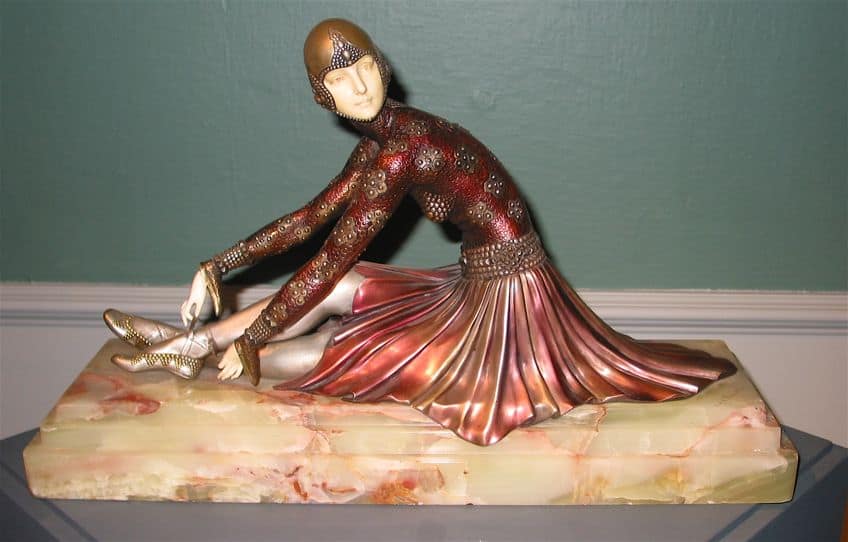
The original version of Art Deco was a visual art style, but during the Roaring Twenties, it became immensely fashionable, especially for interiors. The style developed all the way through to the 1940s but became seen as increasingly decadent after that. It was seen as especially luxurious during the Second World War. Art Deco architecture and art may have faded for a while, but it actually reemerged in the 1960s when Pop Art was on the rise, and it had a strong influence on those forms, and then in the 1980s, Art Deco became a prominent component of graphic design. This form has continued to have a strong influence over the subsequent decades.
One of the major reasons that you cannot view Art Deco as an architectural style alone is because it was fundamentally an embracing of a variety of art forms. It was architecture, interior design, fashion, jewelry, ornamentation, and industrial design. Art Deco architectural projects were often a collaboration between several different artists to create a unified expression.
This is one of the central Art Deco architecture characteristics; a unified form of architecture and art working in conjunction with one another.
Art Deco Architecture Characteristics
The 1920s Art Deco architecture that would go on to influence Art Deco architecture through the decades was especially decadent in much of its design. The materials that were used were especially luxurious, but they will be discussed in the section below. For now, let’s have a look at Art Deco-style architecture and what it looked like. Art Deco architecture is fundamentally based on smooth lines. These lines are highly stylized in design and they’re often streamlined in their appearance. Art Deco makes use of consistent geometric shapes, and many of these shapes are machine-age forms. There are many chevrons, sunburst motifs, and zigzag designs. This style of architecture and art was meant to be incredibly modern in its design.
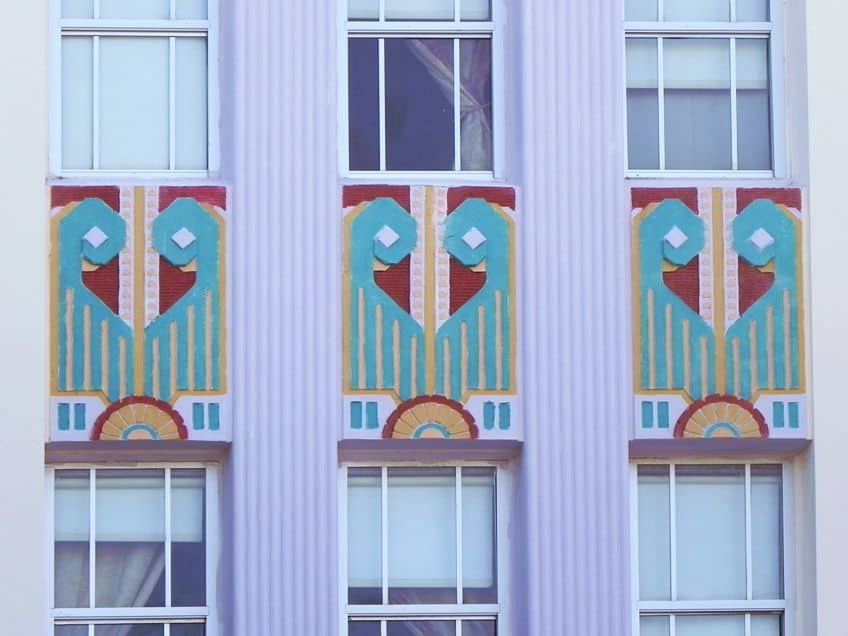
The modernism of Art Deco comes from an eclectic blend of influences. The focus on geometric shapes comes from the Cubism influences that Art Deco architecture took on board, and the more machine-oriented forms derived from Constructivist and Futurist sources. There is also influence from Art Nouveau but as an opposition. Not to mention the seemingly random and disparate sources of inspiration that came from places like Egyptian, Aztec, and Greco-Roman art.
Art Deco architecture is all about the future.
It was the modern era and things were changing at a rapid rate. Art Deco-style architecture wanted to seek a more scientific and technological form of art that was based on newer, industrial ideas. These ideas were also processed through the lens of often expensive materials to produce a luxurious image of modern living.
Materials of Art Deco Architecture
Art Deco architecture saw some radical changes from its initial existence through to its later developments. The whole style was essentially a response to the way things were in World War One. Major wars of that variety tend to lead to austerity measures as more and more resources are siphoned away from civilians and are instead sent away to the military. This all meant that luxury was even more of a luxury than before during the First World War. So, Art Deco architecture decided to reverse course on that kind of approach. Instead, the earliest Art Deco buildings made use of expensive materials like lacquer, jade, silver, crystal, horns, and ivory. It wasn’t about architecture and art alone; it was about making a statement.
This is the kind of statement that could only be made in 1920s Art Deco architecture because as soon as the 1920s came to an end, there was a little economic blip that a few people may have heard of: the Great Depression. This intense economic depression caused quite a few things to change.
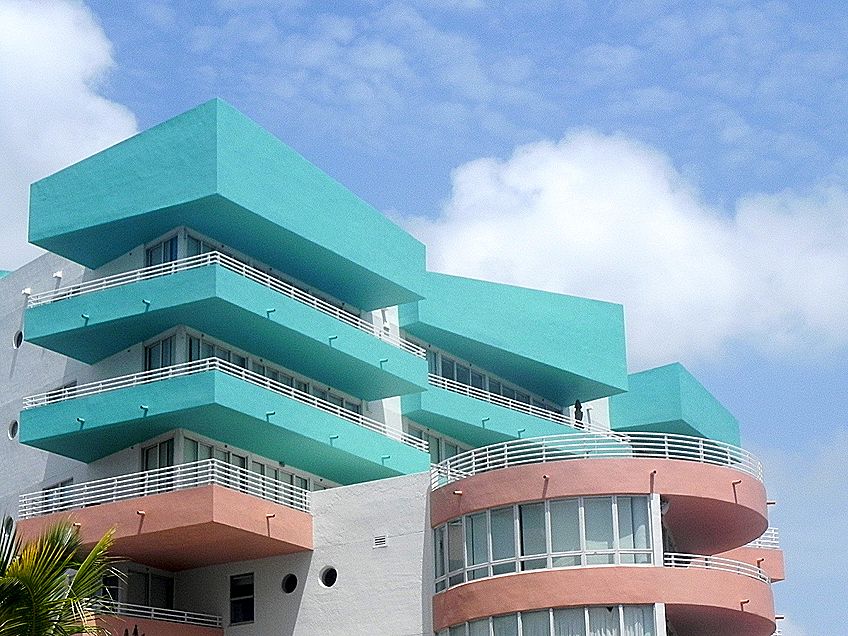
One of the biggest changes that were made to Art Deco architecture because of factors like the Great Depression was the new use of far cheaper materials. However, the overall vibe and tone of Art Deco needed to be maintained, so these cheaper materials, while often mass-produced, could lend an appearance of luxury. This is where materials like chrome and plastic became a prevalent Art Deco architecture characteristic. While materials of this description are far less illustrious as symbols of wealth and decadence, they did allow for a greater expansion of Art Deco architecture through the Great Depression and out the other end.
It was a decadent style that managed to beat the kind of economic downturn that tends to eliminate decadent excesses. The kind of decadent excesses that can be found in many of the most famous Art Deco buildings.
A Few Art Deco Buildings
Let’s have a look at some of the most famous Art Deco buildings. While Art Deco has definitely managed to make an international impact, it was especially prevalent in the United States. It really took root in the country, and many of the most famous examples of Art Deco architecture can be specifically found in New York City. So, let’s have a look at some of those structures.
Théâtre des Champs-Élysées (1911 – 1913) in Paris
| Architect | Auguste Perret (1874 – 1954) and Gustave Perret (1876 – 1952) |
| Date Constructed | 1911 – 1913 |
| Function | Entertainment venue |
| Location | Paris, France |
The Théâtre des Champs-Élysées is a theater in Paris. It isn’t a particularly large theater in terms of the scale that many modern theaters are able to accommodate seeing as it can seat 1,905 people in its main hall, 601 in its comedy club, and 230 in its studio. But regardless of its comparatively small size, it is a stunning example of early Art Deco architecture.
The originating name of Art Deco would only come after this building was designed and constructed, so it was way ahead of its time and it was also considered to be the first Art Deco building in Paris. The Théâtre des Champs-Élysées was designed with reinforced concrete that made use of a variety of artistic expressions inside and outside the building.
There are rectangular angles and straight lines that run from the inside to the outside, and the whole building is adorned with marble and stucco plaques. The building contains a relief, dome, paintings, and a stage curtain that were all designed by different people. They were all respected artists, sculptors, and architects. This union of various creative groups indicates an early preference for the unity of style that Art Deco sought.
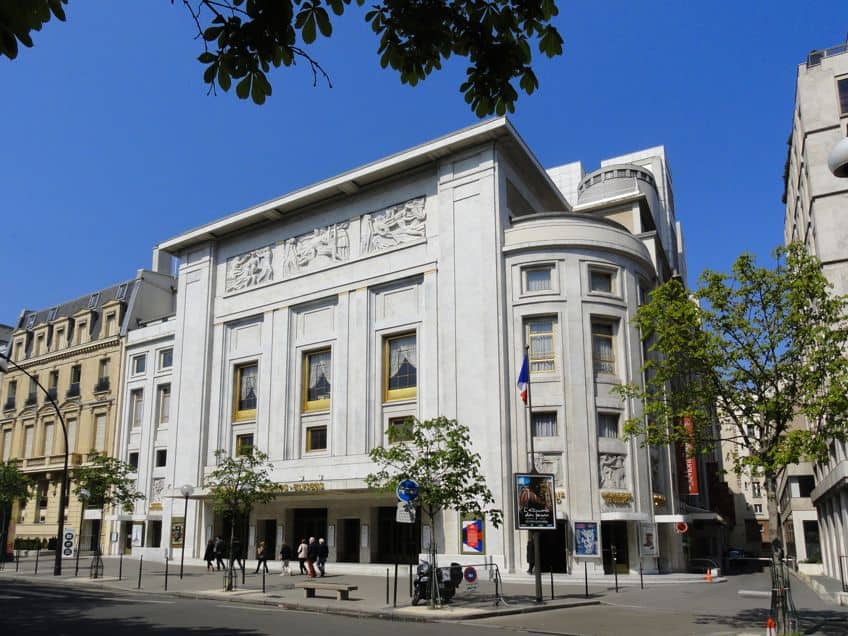
In addition, the Théâtre des Champs-Élysées was the location for the premiere of Igor Stravinsky’s The Rite of Spring performance. This performance actually provoked a small riot because of the content depicted within the ballet. This theater is open to this day, and it houses operas and other performances.
American Radiator Building (1923 – 1924) in New York City
| Architect | Raymond Hood (1881 – 1934) and André Fouilhoux (1879 – 1945) |
| Date Constructed | 1923 – 1924 |
| Function | Hotel |
| Location | New York City, United States |
The American Radiator Building is a good example of 1920s Art Deco architecture. The building was designed, as you may expect, as the American Radiator Company’s headquarters. However, this company merged with another company and later sold this piece of Art Deco architecture, and it has exchanged hands many times since, but it has existed as the Bryant Park Hotel since 2001 and the annex to the building has been the Guttman Community College since 2012. These many changes do not reflect the original nature of this building though. The American Radiator Building was constructed as one of the earliest skyscrapers. It was 23 stories tall and had a height of 103 m (or 338 ft), but it later received an add-on in the form of a five-story annex.
These two buildings would be somewhat independent for much of their existence.
The building was designed to have a very different feeling from many of the other buildings in the city. The architect specifically chose that the façade of the building would be in black brick so that it could stand out against the usual gray and white buildings around it. In addition, the American Radiator Building makes use of gold-colored decorations on its pinnacles and setbacks, and this gives it a truly distinct look that is unlike anything else in the city.

The base of this Art Deco building was constructed out of polished Swedish granite, and the black brick started on the third floor. The original base was done in a fairly traditional Gothic style, but the Art Deco ornamentation altered the overall look of the structure and made it stand out, but the building was also never what it meant to be.
There was originally supposed to be a tower that was even taller than the building, but the plans for that had to be scrapped because of the Great Depression.
However, the American Radiator Building was known for a very innovative elevator design at the time, and those elevators were so innovative because they allowed you to push a button to open doors, plus, they were more automatic. Basically, they’re normal ones by today’s standards, but clearly modern for the time, and being modern for the time was definitely an Art Deco preference.
Chrysler Building (1928 – 1930) in New York City
| Architect | William Van Alen (1883 – 1954) |
| Date Constructed | 1928 – 1930 |
| Function | Office rental |
| Location | New York City, United States |
The Chrysler Building is an extremely famous skyscraper that was, for less than a year, the tallest building in the world. It stands 319 m (or 1,046 ft) tall and is, to this day, considered the tallest brick building with a steel frame. However, that is not quite as impressive as the eleven months that it served as the tallest building in the world.
The building was funded by Walter Chrysler, the head of the company named after him and his family, but while the building was built for the company, it was not owned by the company. Instead, it was personally owned by Walter Chrysler until it was sold. Since then, it has served as office space for a variety of companies.
The building itself is a steel-framed building that is otherwise constructed out of brick, but one of the major elements of this building is that it has several prominent ornaments throughout the exterior. There are over fifty metal ornaments that resemble gargoyles, there are some actual gargoyles, there are replicas of 1929 radiator caps, and there are also eagles adorned on one of the floors as a representation of the United States.
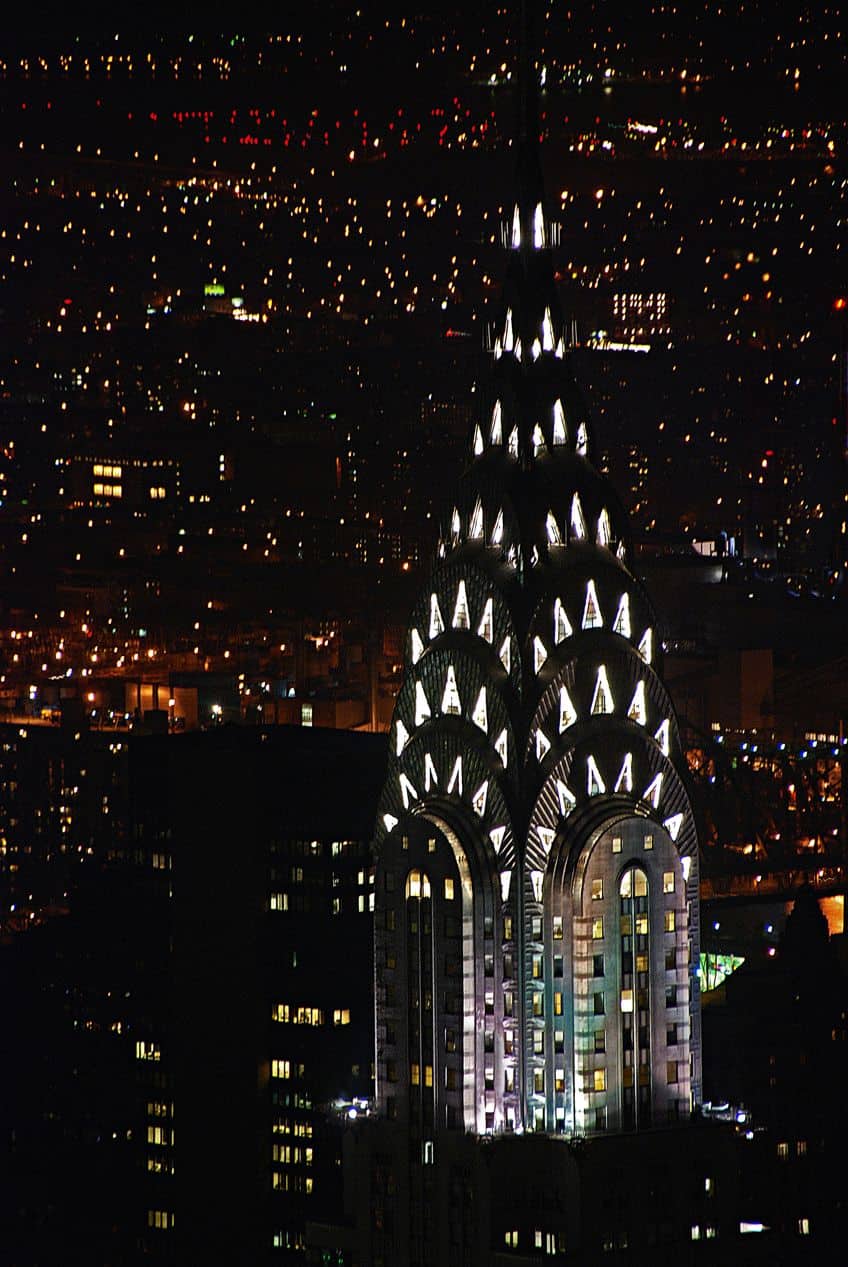
The exterior of the building is designed to have a ziggurat design from one side and a U-shaped palazzo design from the other that starts with black granite on the ground floor, then a few floors of white marble, and lastly the masonry that has come to define it. However, the crown cannot be forgotten. One of the most Art Deco aspects of the Chrysler Building is that the very top of the structure is adorned with a highly decorative crown with a sunburst image set against a design that is reminiscent of the spokes of a wheel. This crown has become one of the most iconic aspects of this piece of Art Deco-style architecture.
Empire State Building (1930 – 1931) in New York City
| Architect | Shreve, Lamb, and Harmon Associates |
| Date Constructed | 1930 – 1931 |
| Function | Office rental and observation deck |
| Location | New York City, United States |
One cannot discuss Art Deco architecture in general without mentioning one of the most famous instances of this form: the Empire State Building. This building has gone on to become one of the most famous in the world, especially because of its heavy use in films, such as King Kong. The Empire State Building has transcended the architectural style to become something of a household name around the world.
This famous building would claim the title of the tallest building in the world less than a year after the Chrysler Building claimed it. However, unlike the Chrysler Building, the Empire State Building held onto the title for decades. Those decades likely contributed to this Art Deco building becoming the iconic structure that it is today.
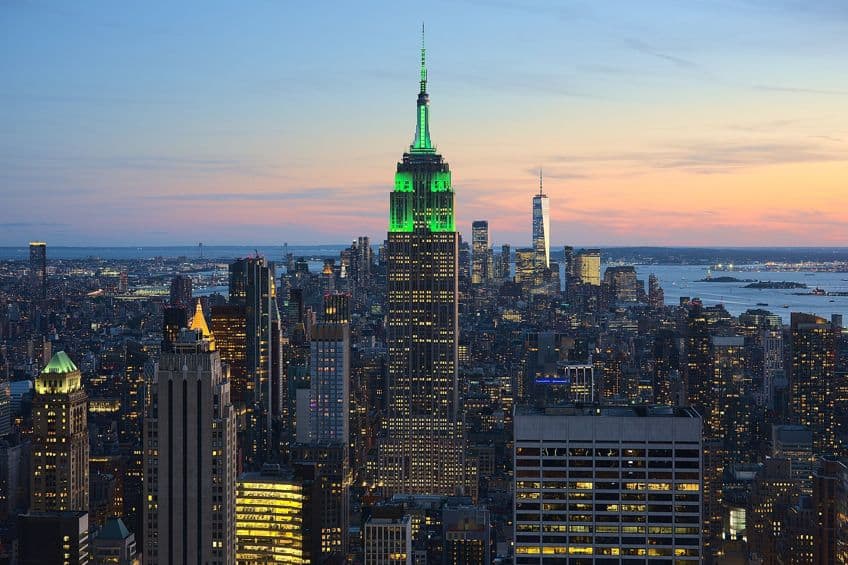
The limestone façade of this structure gives way to the many sculptured sections along the walls and the column-inspired design that runs up the length of the building, although it’s the interior of this Art Deco building that really shines. There are many reliefs and panels throughout the interior that show the machine-inspired influence that became so closely associated with the Art Deco movement. The Empire State Building is not only one of the most famous Art Deco buildings, but it is also just one of the most famous buildings in the world.
Rockefeller Center (1930 – 1939) in New York City
| Architect | Raymond Hood (1881 – 1934) |
| Date Constructed | 1930 – 1939 |
| Function | Mixed-use |
| Location | New York City, United States |
The Rockefeller Center is a collection of buildings that were commissioned by the Rockefeller Family in the Art Deco style. These buildings all surround one central structure called the Comcast Building or, more famously, 30 Rockefeller Plaza. This Art Deco skyscraper stands high above the rest at 260 m (or 850 ft) tall and has become an absolutely iconic monument in New York City. The building features a stepped design because of the 1916 Zoning Resolution that put restrictions on how buildings could be constructed in the city.
This, however, works well with the flat roof which is not particularly common in Art Deco buildings. There are also many highly Art Deco-oriented aspects of this design though.
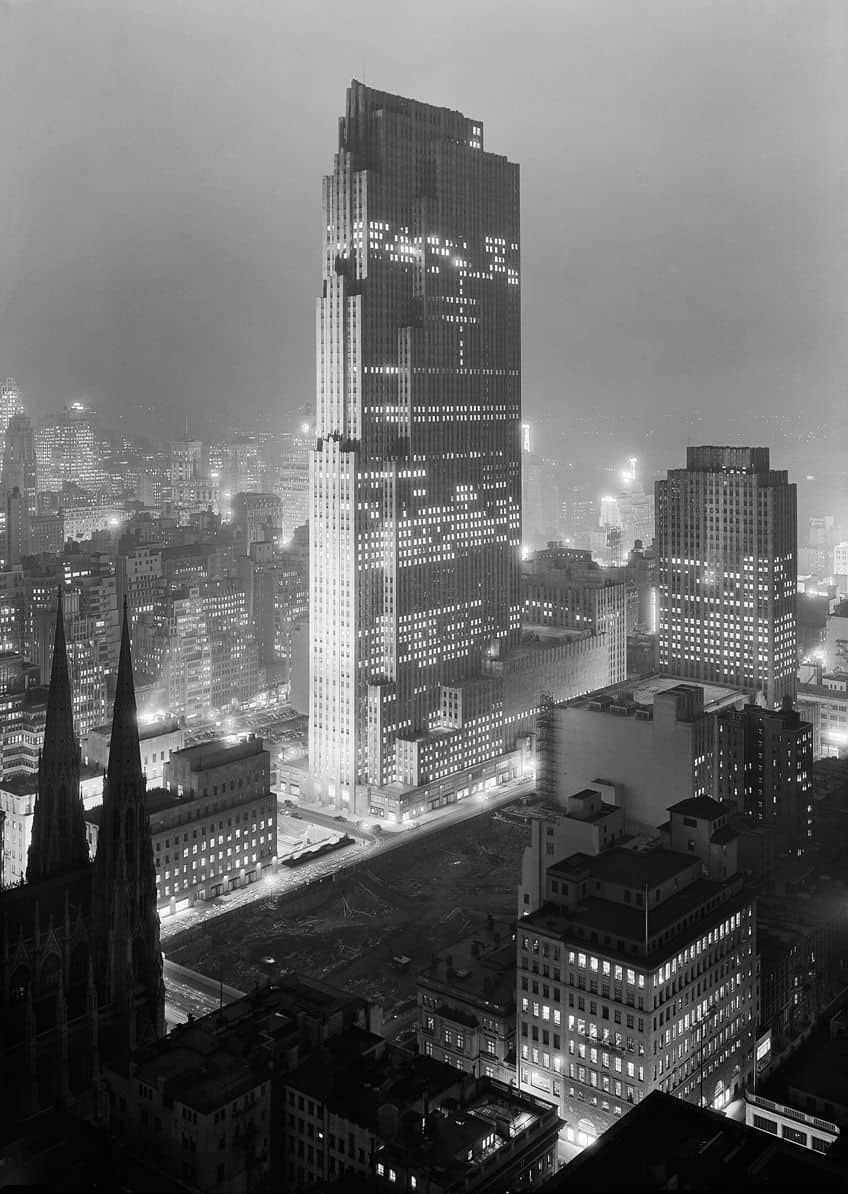
One of the biggest and most important aspects of Art Deco design is the consistent use of art throughout the structure, and this is especially prevalent in this building. There are sculptures, fountains, and carvings throughout the building and the streets around it. The interior is also decorated with Art Deco paneling and intricate frescos. Ultimately, all of these factors came together to turn this limestone-covered building into one of the most iconic sights in the city.
Art Deco architecture burned bright during the 1920s and 1930s, but its influence refused to wane for long as it returned as an influence on many other architectural styles and other artforms multiple times throughout history. There will likely be an Art Deco resurgence over and over again for years to come, and with its simple, geometric designs and its affiliation with the arts, perhaps this style should make repeated comebacks.
Frequently Asked Questions
Where Does the Name Art Deco Come From?
The term itself comes from the name of an expo that happened in Paris in 1925. The expo was called the Exposition Internationale des Arts Decoratifs Industriels et Modernes. This expo introduced Art Deco as a form of decorative art, that would go on to influence architecture and design for several decades. It still has influence today, but perhaps not quite as strongly as it once did.
Who Were the Most Famous Art Deco Figures?
Some of the major figures in Art Deco architecture included individuals like the designer and interior decorator Émile-Jacques Ruhlmann (1879 – 1933), who created furniture that had sleek and expensive designs. Others included immensely influential Art Deco architects like Raymond Hood (1881 – 1934), who designed the American Radiator Building, or the pioneering William Van Allen (1883 – 1954), who designed the Chrysler Building.
Is Art Deco Still Prevalent Today?
Art Deco has seen something of a resurgence in recent years. There has not necessarily been a resurgence in Art Deco architecture, but the art style has become a prominent and desirable design aesthetic. It has become associated with prosperity, nostalgia, and a modern aesthetic. Art Deco architecture and art have even influenced other mediums in the modern day, such as the 2007 video game, Bioshock, having a setting that is heavily derived from Art Deco sources.
Justin van Huyssteen is a writer, academic, and educator from Cape Town, South Africa. He holds a master’s degree in Theory of Literature. His primary focus in this field is the analysis of artistic objects through a number of theoretical lenses. His predominant theoretical areas of interest include narratology and critical theory in general, with a particular focus on animal studies. Other than academia, he is a novelist, game reviewer, and freelance writer. Justin’s preferred architectural movements include the more modern and postmodern types of architecture, such as Bauhaus, Art Nouveau, Art Deco, Brutalist, and Futurist varieties like sustainable architecture. Justin is working for artfilemagazine as an author and content writer since 2022. He is responsible for all blog posts about architecture.
Learn more about Justin van Huyssteen and about us.
Cite this Article
Justin, van Huyssteen, “Art Deco Architecture – Buildings of the Art Deco Period.” artfilemagazine – Your Online Art Source. April 12, 2023. URL: https://artfilemagazine.com/art-deco-architecture/
van Huyssteen, J. (2023, 12 April). Art Deco Architecture – Buildings of the Art Deco Period. artfilemagazine – Your Online Art Source. https://artfilemagazine.com/art-deco-architecture/
van Huyssteen, Justin. “Art Deco Architecture – Buildings of the Art Deco Period.” artfilemagazine – Your Online Art Source, April 12, 2023. https://artfilemagazine.com/art-deco-architecture/.


